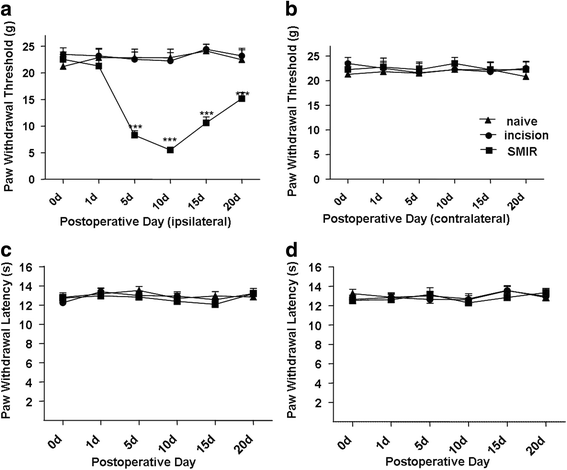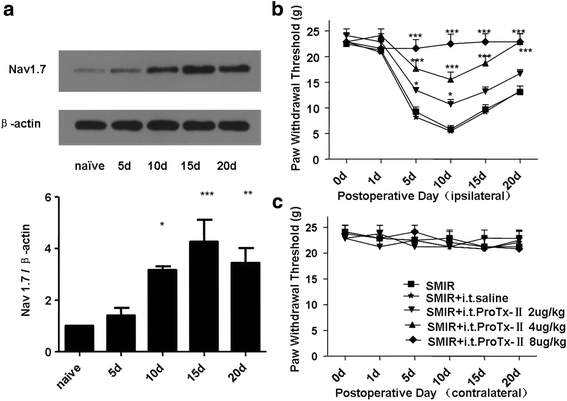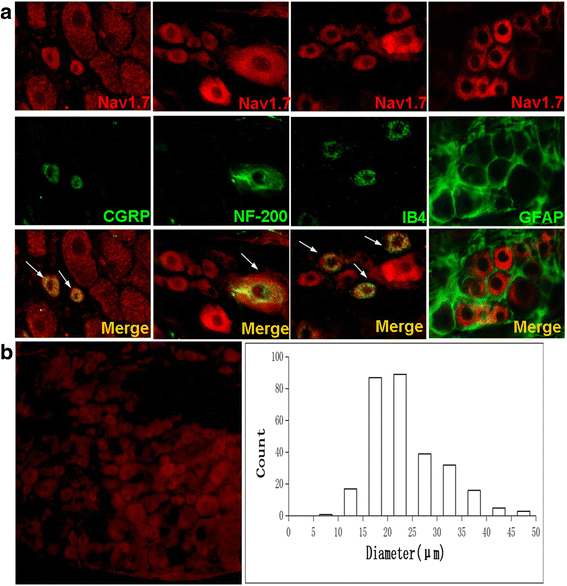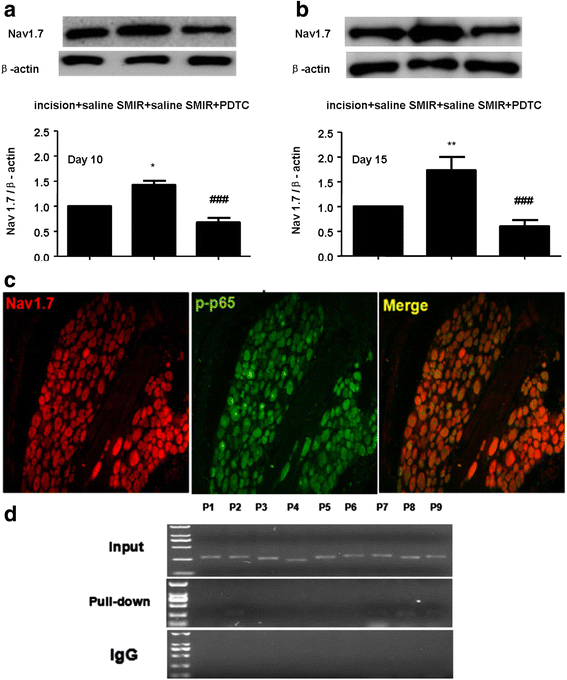Membrane protein Nav1.7 contributes to the persistent post-surgical pain regulated by p-p65 in dorsal root ganglion (DRG) of SMIR rats model
- PMID: 29115943
- PMCID: PMC5678798
- DOI: 10.1186/s12871-017-0438-8
Membrane protein Nav1.7 contributes to the persistent post-surgical pain regulated by p-p65 in dorsal root ganglion (DRG) of SMIR rats model
Abstract
Background: Persistent post-surgical pain is a difficult clinical problem. In this study, we intend to explore the mechanism underlying the persistent post-surgical pain in SMIR (skin/muscle incision and retraction) rats.
Methods: First of all, the expression of membrane protein Nav1.7 and p-p65 (Phosphorylation of p65) were detected in ipsilateral L4-6 DRGs of SMIR rats by western-blot and immunostaining. Then with ProTx-II (Nav1.7 blocker) or PDTC (p65 inhibitor) were intrathecally injected while the change of Nav1.7 expression and mechanical withdrawal threshold were detected. Finally chromatin immunoprecipitation assay method was used to detect whether could p-p65 bind in the Nav1.7 gene promoter region directly.
Results: The results shows that mechanical hyperalgesia occurs following SMIR model, from 5 day (d) and lasted more than 20d after surgery. Meanwhile, the expression of Nav1.7 was up-regulated at 10d, 15d and 20d after surgery compared with naïve group. The expression of p-p65 was up-regulated at 10d and 15d compared with incision group. The mechanical hyperalgesia induced by SMIR was reversed after blocking Nav1.7 or inhibiting p65. Furthermore, Nav1.7 expression was down-regulated when p-p65 was inhibited and p-p65 could combine with the Nav1.7 gene promoter region directly.
Conclusion: Membrane protein Nav1.7 could participate in the peripheral sensitization of persistent post-surgical pain, which may be regulated by p-p65.
Keywords: DRG; Mechanical hyperalgesia; Nav1.7; P-p65; Persistent post-surgical pain.
Conflict of interest statement
Ethics approval
Animal experiments were approved by the Ethics committee of Henan province. Zhengzhou, Henan, China.
Consent for publication
Not applicable
Competing interests
All authors declare that they have no competing interests.
Publisher’s Note
Springer Nature remains neutral with regard to jurisdictional claims in published maps and institutional affiliations.
Figures





Similar articles
-
p38 and interleukin-1 beta pathway via toll-like receptor 4 contributed to the skin and muscle incision and retraction-induced allodynia.J Surg Res. 2015 Aug;197(2):339-47. doi: 10.1016/j.jss.2015.04.061. Epub 2015 Apr 21. J Surg Res. 2015. PMID: 25979559
-
The role of P2X7R/ERK signaling in dorsal root ganglia satellite glial cells in the development of chronic postsurgical pain induced by skin/muscle incision and retraction (SMIR).Brain Behav Immun. 2018 Mar;69:180-189. doi: 10.1016/j.bbi.2017.11.011. Epub 2017 Nov 17. Brain Behav Immun. 2018. PMID: 29155323
-
Forced treadmill running suppresses postincisional pain and inhibits upregulation of substance P and cytokines in rat dorsal root ganglion.J Pain. 2014 Aug;15(8):827-34. doi: 10.1016/j.jpain.2014.04.010. Epub 2014 May 20. J Pain. 2014. PMID: 24854064
-
The different mechanisms of peripheral and central TLR4 on chronic postsurgical pain in rats.J Anat. 2021 Jul;239(1):111-124. doi: 10.1111/joa.13406. Epub 2021 Mar 17. J Anat. 2021. PMID: 33730389 Free PMC article.
-
TLR4/NF-κB signaling activation in plantar tissue and dorsal root ganglion involves in the development of postoperative pain.Mol Pain. 2018 Jan-Dec;14:1744806918807050. doi: 10.1177/1744806918807050. Epub 2018 Oct 1. Mol Pain. 2018. PMID: 30270727 Free PMC article.
Cited by
-
Influence of androgenic blockade with flutamide on pain behaviour and expression of the genes that encode the NaV1.7 and NaV1.8 voltage-dependent sodium channels in a rat model of postoperative pain.J Transl Med. 2019 Aug 27;17(1):287. doi: 10.1186/s12967-019-2031-z. J Transl Med. 2019. PMID: 31455381 Free PMC article.
-
Genome-Wide Expression Profiling by RNA-Sequencing in Spinal Cord Dorsal Horn of a Rat Chronic Postsurgical Pain Model to Explore Potential Mechanisms Involved in Chronic Pain.J Pain Res. 2022 Apr 5;15:985-1001. doi: 10.2147/JPR.S358942. eCollection 2022. J Pain Res. 2022. PMID: 35411184 Free PMC article.
-
Age-related molecular changes in the lumbar dorsal root ganglia of mice: Signs of sensitization, and inflammatory response.JOR Spine. 2020 Sep 13;3(4):e1124. doi: 10.1002/jsp2.1124. eCollection 2020 Dec. JOR Spine. 2020. PMID: 33392459 Free PMC article.
-
NGF-Induced Nav1.7 Upregulation Contributes to Chronic Post-surgical Pain by Activating SGK1-Dependent Nedd4-2 Phosphorylation.Mol Neurobiol. 2021 Mar;58(3):964-982. doi: 10.1007/s12035-020-02156-1. Epub 2020 Oct 16. Mol Neurobiol. 2021. PMID: 33063281
-
Discordance between preclinical and clinical testing of Na V 1.7-selective inhibitors for pain.Pain. 2025 Mar 1;166(3):481-501. doi: 10.1097/j.pain.0000000000003425. Epub 2024 Oct 23. Pain. 2025. PMID: 39928833 Free PMC article. Review.
References
-
- de Leon-Casasola, O. 2014. A review of the literature on multiple factors involved in postoperative pain course and duration. Postgrad Med 126:42-52. - PubMed
MeSH terms
Substances
LinkOut - more resources
Full Text Sources
Other Literature Sources

